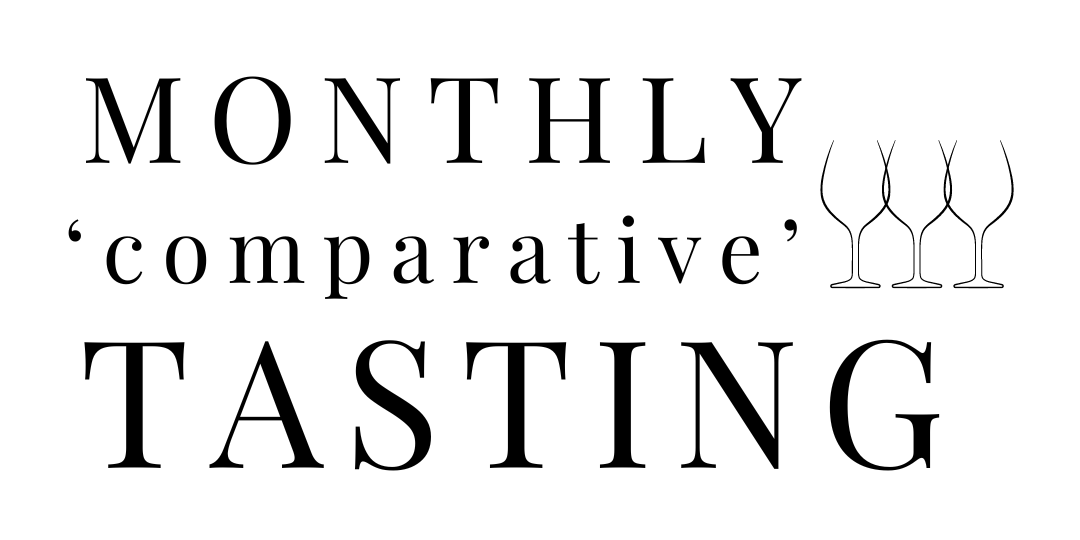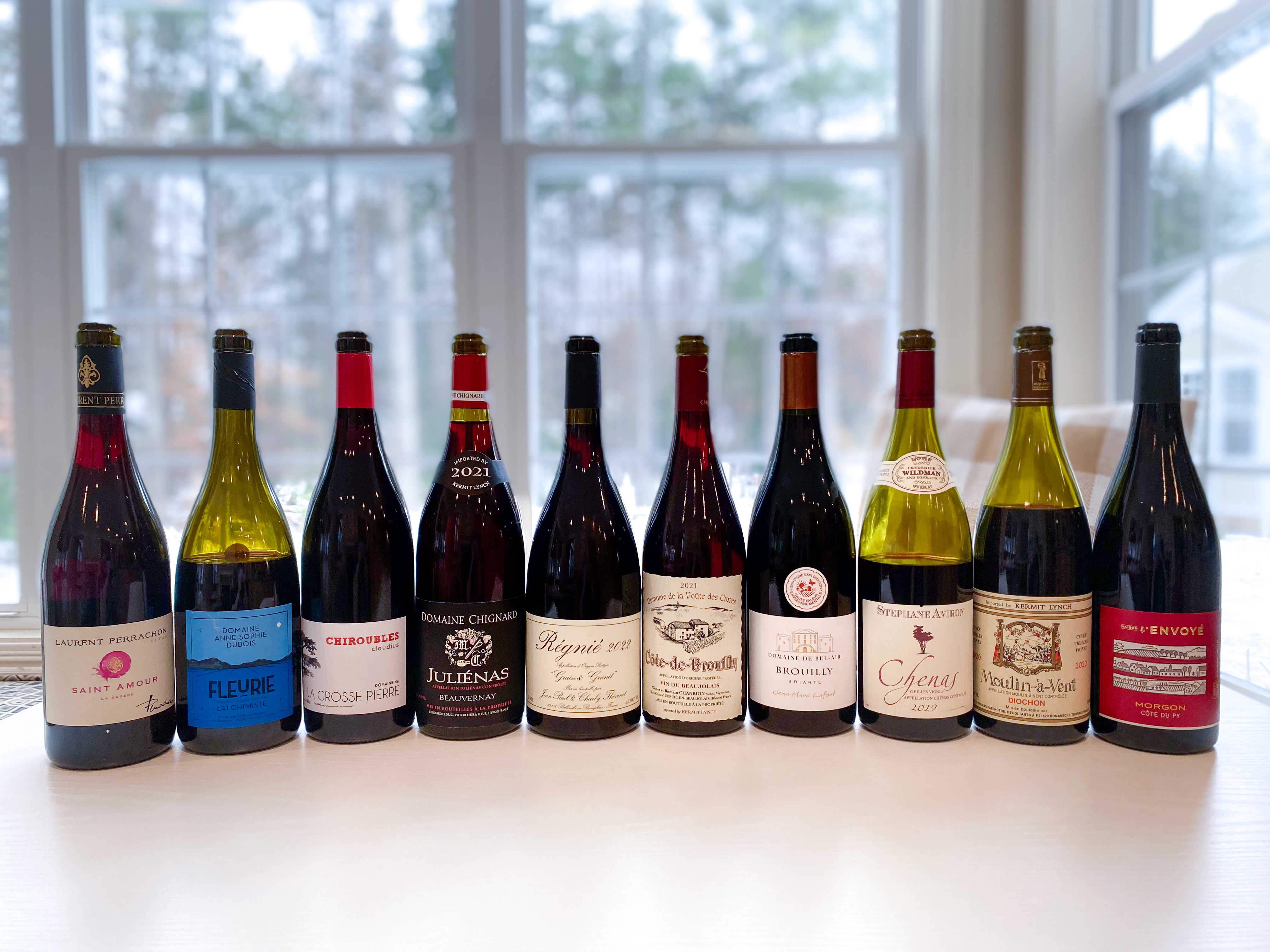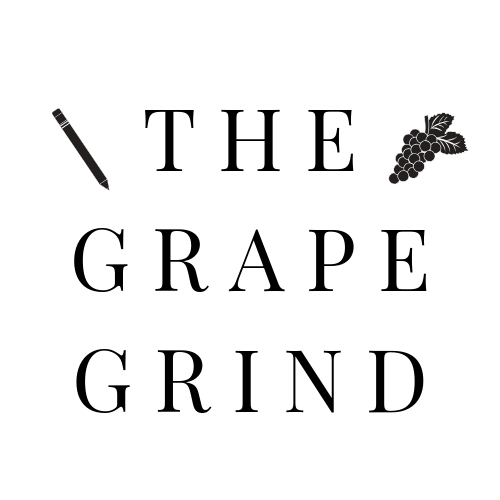

10 Cru’s of Beaujolais!
10 Cru’s of Beaujolais!

How this works…
1. Grab any of the following wines from the list below.
2. Taste along with the videos following.
3. Add your thoughts to the comments!
oh… and download and print the free PDF below to keep track of your notes!
Flight 1
(lighter/delicate styles)
1. Saint-Amour
2. Fleurie
3. Chiroubles
Flight 2
(moderate/structured styles)
1. Julienas
2. Regnie (some might consider this more on the delicate side)
3. Cote de Brouilly (some might consider this more age-worthy)
4. Brouilly
Flight 3
(heavier/age-worthy styles)
1. Chenas
2. Moulin-a-Vent
3. Morgon
Flight 1
1. Saint-Amour
(I have Laurent Perrachon)
- Background: This one is named after a Roman soldier turned missionary. A powerful marketing tool for Valentine’s day and ⅓ of bottles are sold around Valentine’s day!
- Soil: The most diverse! Silica quartz in some areas lends to lighter/brighter wines. Clay in other areas lends to heavier wines. Some limestone, some volcanic bedrock, and only some granite.
- Climate: Moderate/Continental
- Landmarks: most northerly (bordering Burgundy). Most of the vineyards are located mid slope feet on all sides of the Mont de Bessay. Steeper slopes in the north. More gentle slopes in the southeast.
- Tasting Notes: Light, fruity, juicy, versatile! Can be either light and fruity or rich and structured depending on the soils. Known as a ‘multiple personalities’ Cru for that reason. Soft red fruits, stone fruit, velvety, and plush overall. Fresh with structured tannin.
2. Fleurie
(I have Anne–Sophie Dubois)
- Background: Wines from Fleurie are known for their floral element (hence the appellation’s name– fleur means flower in French). Within the last couple of decades, this has become one of the most known, and sought-after Cru’s!
- Soil: Mostly composed of granite (pink granite)! This covers 90% of the area. They are lighter soils, giving more lifted/bright wines.
- Climate: Moderate/Continental
- Landmarks: Fleurie is the third largest cru in the region located on steep slopes, with most of the vines growing on gentler slopes towards the east and south. Steeper slopes are on the western side where there is a range of famous hills and peaks can be around 1,300 ft.
- Tasting Notes: The combination of the higher elevation, sloped vineyards, and pink granite soils create aromatic wines! Known to be the most floral (violets) with red berries, good fruit density, sweet spice, slightly herbaceous, and noticeable “minerality” and freshness. Lively, silky, and finessed!
3. Chirobles
(I have La Grosse Pierre)
- Background: Smallest Cru (so a harder one to find)! Known to be a good “transition” Cru from Village wines. Used to be meant to be consumed young, but more complex styles are emerging! Also the steepest vineyards! Many consider the growers of this cru heroic for the physical demands of working such steep and rugged hills.
- Soil: 100% Granite – the only one whose terroir is composed solely of granite (some traces of a thin layer of clay). Therefore, the most homogenous Cru!
- Climate: Cool/Continental (cooler climate than others because of higher elevation). Fruit that is harvested a week later than all other crus. In warmer years, this is an advantage.
- Landmarks: The highest of all – an average of 1,200 feet elevation up to 1,800 feet. 30% + angles facing east and south.
- Tasting Notes: This one has been called the most “Beaujolais” of all the Cru’s. Easy drinking, soft, and light. Wild raspberries, cherry, red flowers, and licorice! Fairly simple and the least aromatic of the lighter styles. I noticed deeper color in this wine (sun exposure). Medium structural components with medium-plus to high acid.
Flight 2
1. Julienas
(I have Domaine Chignard)
-
Background: Larger Cru that’s slightly west of Saint-Amour. Considered “the big brother” of Saint-Amour. Julius Cesar is said to be the origin of the name and could have been the birthplace of vines in Beaujolais. Can be very ageworthy!
-
Soil: Similar to Saint-Amour, there is highly variable soil here, with a mix of alluvial, sand, and clay. More topsoil and clay giving more powerful wines (almost no granite here)
-
Climate: Moderate/Continental. South-southwest exposure, it gets a lot of sun lending to denser wines in warm vintages.
-
Landmarks: Like Saint-Amour, most of the vineyards are located on Mont de Bessay but they are higher on the hills (over 1300 feet). It is the third steepest vineyard (after Chiroubles and Côte de Brouilly). This area is sheltered from northern and eastern winds, so the grapes tend to ripen a little later than average for Beaujolais.
-
Tasting Notes: A little more structured than the others. Mostly red fruit (cherry, pomegranate, cassis) with dark plum and spices (cinnamon) and cedar. Herbal and savory. An ‘earthy’ Cru that’s ruby in color and aromatic.
2. Regnie
(I have Jean-Paul Thévenet)
-
Background: One of the “newer” Cru’s …or last to be recognized (in 1988). Southwest of Morgon. Wines are typically meant to be consumed early.
-
Soil: Poor soils are mostly composed of decomposed pink granite with a lot of sand and some silica.
-
Climate: Moderate/Continental.
-
Landmarks: Good elevation here (1,000 ft average) on the slopes of the Avenais mountains.
-
Tasting Notes: The profile is close to Chirobles (although way more soil variation). Both fresh and with good character. Very aromatic with savory notes. Slightly medicinal. Raspberry, cherry, and mineral notes. Velvety and peppery. Medium tannin. Good acid.
3. Brouilly
(I have Jean-Marc Lafont)
-
Background: The most southern Cru, which connects to Beaujolais-Villages. The appellation circles around Côtes-de-Brouilly. It is the largest Cru and very high production. It’s identity is not so clear because they are usually a blend of wines from diverse soils. It’s known to be friendly and accessible and at plenty of the bistro’s in Paris!
-
Soil: The soil here is thin and not very fertile. Most has eroded from the hill. Pink granite and clay on the west side, Volcanic soils in the north. South is limestone, sandstone, gravel, and schist.
-
Climate: Moderate/Continental.
-
Landmarks: The appellation circles around the Mont Brouilly on the flatter areas (varying steepness). Since 2018, Brouilly is at the heart of the UNESCO Geopark of the Beaujolais, to highlight the biodiversity and terroir of the area.
-
Tasting Notes: Simpler “textbook” Beaujolais! Cherry and fresh minerality. More ruby in color. Medium bodied wines. Lower acid and higher tannin. Slightly floral, mostly fruity! LOTS OF CHERRY.
4. Côte-de-Brouilly
(I have Nicole Chanrion)
- Background: Located in the center of Brouilly these wines are from the slopes and are said to be better exposed and of higher quality. Mont Brouilly is the remains of the edges of an old volcano weathered over millions of years. Côte translates to a hillside in French. These wines can be made of different levels of ripeness.
- Soil: Schist is on the northern side, Granite is on the west. Higher clay content is on the east. The rest is alluvial and colluvial sediment.
- Climate: Moderate/Continental.
- Landmarks: Vineyards cover the slopes of the Mont Brouilly. The Mont is one of the most symbolic. It is where the Chapel of Notre-Dame-aux-Raisins is located. AKA “Our Lady of the Grapes”. It was built after devasting frosts and powdery mildew attacks in the 1850s. It was an ask of God to provide plentiful crops. It is the second steepest cru after Chiroubles, with many vineyards on more than 50% steepness. It is not very high, however, only 1,000 ft. All the sides are covered, including the west, which is rare.
- Tasting Notes: Ripeness and Freshness (some can mirror Morgon). In general, the style tends to be riper, with good concentration and aromatics. Dark berries and volcanic ‘smoky’ elements. Purple wildflowers. Great structure and long finish.
Flight 3
1. Chenas
(I have Stéphane Aviron)
- Background: The smallest cru! 1 square mile of slope and 100 producers. RARE – A few examples are exported to the U.S. Once a part of Moulin-a-Vent and similar to it. After splitting from Moulin-a-Vent, winemakers had a choice between labelling their bottles Moulin-à-Vent or Chénas; and since there was more demand for Moulin-à-Vent, most vignerons opted for that label. Gets its name from the word chêne, which is ‘oak tree’ in French.
- Soil: Pink granite is the west, clay in the east.
- Climate: Moderate/Continental.
- Landmarks: Steep slopes on the west, gentle hills on the east.
- Tasting Notes: Powerful and fleshy. Smoky and black pepper. Spicy and floral. Still a sense of minerality and purity! Evolves over time.
2. Moulin-a-Vent
(I have Domaine Diochon)
- Background: The most famous along with Morgon. Back in the 19th century was as expensive as Grand Cru Burgundy. It was the first cru to ask for recognition in 1924, and it gained AOC in 1936. All other Cru’s are named after a village, this one is named after a windmill built in 1550. Used traditional maceration (similar to Burgundy) vs Carbonic for a long time. Burgundy producers are also involved here (Château des Jacques owned by Jadot).
- Soil: The first Cru to take a geological survey of it’s soil and understand the complexity of its terroir. West is pink and red granite with lots of quartz. East is flat with granite clay and alluvial. Heavier soils than most Cru’s overall.
- Climate: Moderate/Continental.
- Landmarks: Most vineyards on mid slope and mostly mid-facing.
- Tasting Notes: Dark fruits and crushed red flowers. Never too tannic, maintaining an approachable flavor profile in their youth. Somewhat gamey. Often seeing oak. Can age 20+ years.
3. Morgon
(I have Maison L’Envoye)
- Background: The most recongized and the most well known lieux-dits- the most famous of them, the Côte de Py. Considered the post modern Beaujolais with rebels and artistry. Led by Lapierre and his “Gang of Four”. Second largest after Brouilly.
- Soil: Large variation of Terroir. Morgon is known for its “rotten stones” (pierres pourries) found around the Côte de Py and Javernières – highly weathered schist and volcanic soils leading to deeply structured, tannic, long-aging wines. But the majority is made of granite.
- Climate: Moderate/Continental.
- Landmarks: Can have up to three weeks of different picking times, based on various terroir. Northwest is higher elevation (1500ft), southeast is warmer and flatter. Soft hills on the east (more exposed), steep and less exposed slopes on the west.
- Tasting Notes: Smoky dark fruit and savory wild profile. Similar concentration to Moulin-a Vent, but can be more concentrated. Very balanced structure. Plump stone fruit like cherry and plum.


